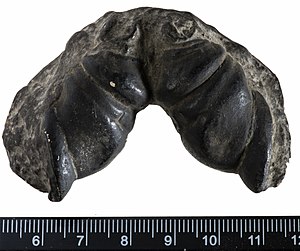Cochliodontiformes
| Cochliodontiformes | ||||||||||||
|---|---|---|---|---|---|---|---|---|---|---|---|---|

Toothed plates of Cochliodus contortus |
||||||||||||
| Temporal occurrence | ||||||||||||
| Moskovium (Upper Carboniferous) to Wuchiapingium ( Upper Permian) | ||||||||||||
| 312 to 255 million years | ||||||||||||
| Locations | ||||||||||||
|
North America, Asia |
||||||||||||
| Systematics | ||||||||||||
|
||||||||||||
| Scientific name | ||||||||||||
| Cochliodontiformes | ||||||||||||
| Obruchev , 1953 |
The Cochliodontiformes are an extinct group of cartilaginous fish , which is mainly known from findings of fossil teeth and tooth plates and occurred from the upper carbon to the upper perm. Outwardly, the fish looked like ray-like, flattened transitional forms between primitive sharks and today's sea cats (Chimaeriformes). Each half of the upper and lower jaw was covered with a long, spirally curved tooth plate. There may have been smaller teeth in front of it. The tooth plates were very similar to those of Jurassic sea cats. Cross lines on the tooth plates suggest that they arose from the growing together of several individual teeth.
The Cochliodontiformes are close relatives of the sea cats and are considered to be their sister group . Similar to the sea cats, the upper jaw (the palatoquadratum) is completely fused with the neurocranium ("brain skull"), a condition called holostyly ("holocephal" = skull made of one piece).
Systematics
The Cochliodontiformes comprise two families , the sister taxon of which is the genus Solenodus , with the only species being Solenodus crenulatus . The family Cochliodontidae comprises eleven and the Psephodontidae comprise two genera.
- Brine mode
- Family Cochliodontidae
- Family Psephodontidae
literature
- John A. Long: The Rise of Fishes . The Johns Hopkins University Press, 1995, ISBN 0801849926
- Joseph S. Nelson : Fishes of the World , John Wiley & Sons, 2006, ISBN 0-471-25031-7
- Alfred Romer : Vertebrate Paleontology. The University of Chicago Press, 1955, ISBN 0-2267-2488-3
Individual evidence
- ^ Cochliodontiformes In: The Paleobiology Database , last accessed on May 11, 2016.